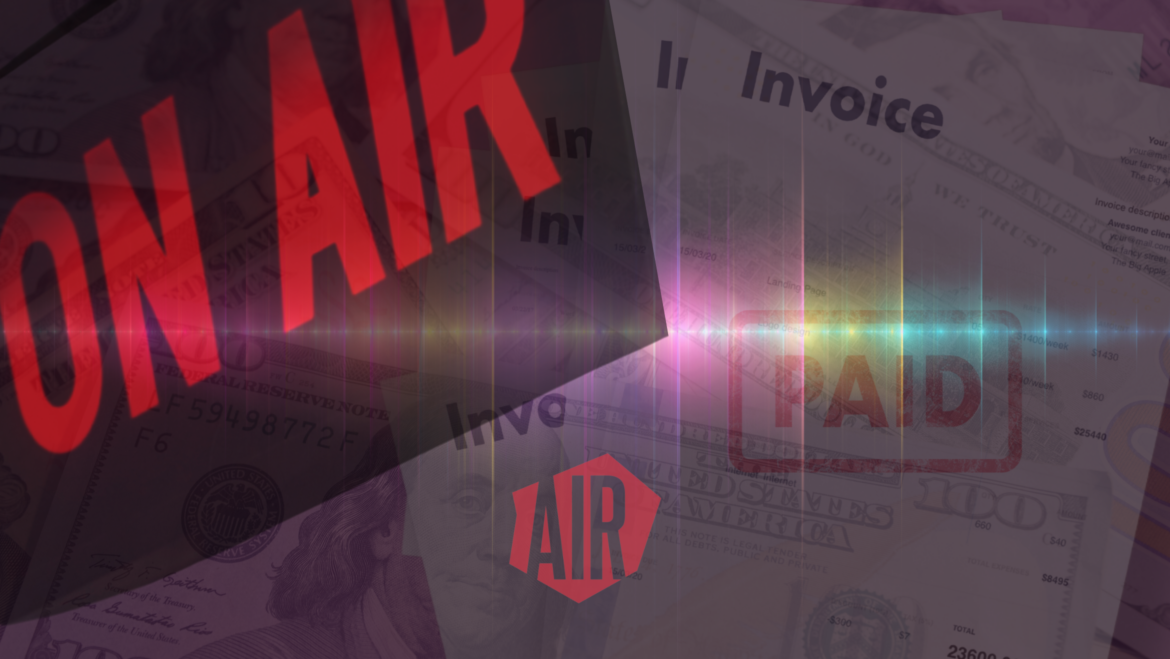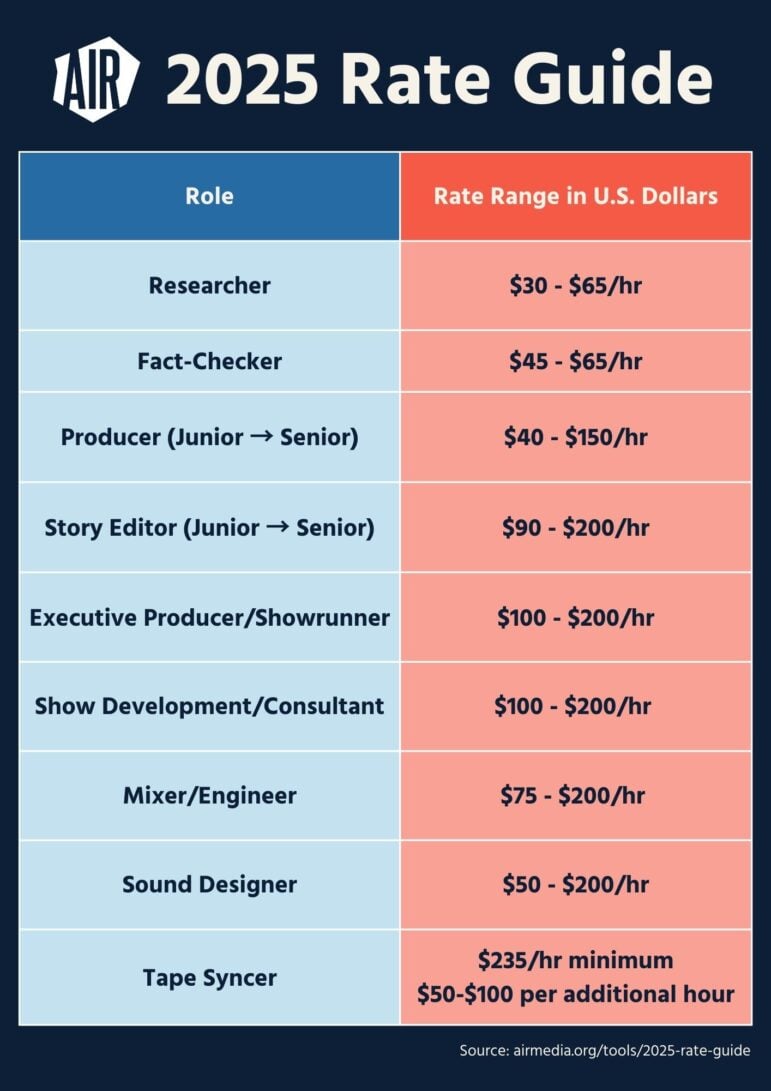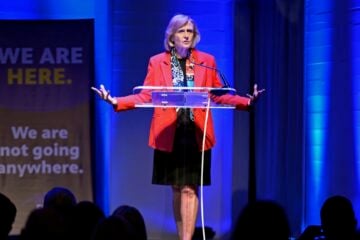What AIR learned from researching freelance rates in 2025

AIR has just released its updated rate guide — a reference document designed to help independent producers, fact-checkers, researchers, editors, sound designers, engineers and consultants better understand fair rates and negotiate confidently. It also serves as a resource for hiring organizations to develop realistic budgets.
With this update, based on a survey conducted over the last few months, we learned that many independent creators are earning far less than their intended rate due to problems like “project bleed” and “scope creep.” To remedy this, we offer suggestions and takeaways to encourage clients and independent creators to consider the many factors that go into a given production, including the timeline and complexity of the project.
We then ask them to combine that with the experience level and skill set of the team, taking into account the producers’ overhead costs such as health insurance, software expenses and basic cost of living. We hope this holistic approach to rates will help create a more equitable and sustainable audio industry.
Freelancers say they face a challenging marketplace. “I think the scariest thing to navigate right now as a freelancer is really understanding the scope of the roles that you’re being hired for and what you can ask for,” says one freelance senior producer and AIR member who prefers to remain anonymous. “Because I would say the entire time in freelancing, 90% of what I’m offered is a gross underpayment. And I’ve either had to fight to get it higher or just walk away.”
How we did it
AIR started the process of updating our rate guide by collecting survey data. We asked respondents for full transparency about their role, the number of hours spent on a given project, and what they were paid across the length of the project. Some respondents reported hourly wages. Others reported “per project” wages.
We received 280 valid responses from across the industry in every role. We then converted all the rates to hourly so we could compare “apples to apples.” We compiled the data and presented it to 50 industry veterans in a series of one-on-one qualitative interviews. The idea was that these practitioners could help analyze our findings and determine whether the rates collected in our survey were accurate. We divided these qualitative interviews into four categories: producers, story editors/consultants, sound designers/engineers and fact-checkers/researchers.
The end result is the 2025 AIR Rate Guide, broken down hourly by role.

The guide itself is in three parts: a breakdown of the rates by role, including some context for how we came to those numbers; a list of “Roles and Responsibilities” outlining each role and the various tasks that are typically associated with each; and AIR’s takeaways and guidance on how to determine your own rate.
AIR’s previous rate guide included a summary of the various roles and the rates associated with each role; this guide provides a more detailed breakdown of “who does what.” This is an effort to educate clients about the many steps that go into creating a segment, episode, or series and the skills needed to execute those steps. The guide also offers a series of takeaways, including our best practices for determining freelance rates in various contexts.
Managing ‘project bleed’
Here are two of our most notable takeaways.
First, freelancers who are paid “per project” rather than “per hour” earn a lower rate over the length of a project. This is because of what’s known as “project creep” or “project bleed,” which happens when a project’s scope of work is not clearly defined and/or the hiring organization gives the producer more work without amending the contract. This can be due to mismanagement or because something unexpected happens over the course of production.
Almost everyone we spoke with had experienced some version of this. We hope the AIR rate guide will educate both freelancers and clients to 1) spend more time developing an idea and understanding exactly what it will take to execute that idea before locking in a long-term contract and 2) build contracts with enough flexibility to allow for unexpected circumstances and changes to the scope of work.
Veteran story editor and AIR member Alison MacAdam works with clients to create a contract that benefits all involved. “What I tend to do is say, ‘Let’s agree on an hourly rate and put a max number of hours per week on it, and then let’s stay in touch.’” she says. “Because I know companies can’t just offer unlimited funds. I understand that. And if it gets to be more than that or things are just not aligning with our expectations, let’s keep talking and figure out what’s doable.”
Second, while we encourage freelancers to figure out an hourly rate that works best for them based on their years of experience and location/cost of living, almost no freelancer consistently earns the same hourly rate from project to project. Freelancers have to adjust their rate based on the complexity of the project, whether it’s for-profit or nonprofit, and how many hours are guaranteed for the length of the project.
Many freelancers we spoke with will lower their rate for friends or passion projects. Similarly, they’ll raise their rate for projects that require specific expertise or that will be especially challenging in some way. This kind of flexibility is needed to create a more sustainable and fair media landscape, and we encourage freelancers and the people who hire them to negotiate in good faith.
“My current main project is with an organization that’s never made a podcast before, so they didn’t know what is considered fair or unfair,” says long-time producer and AIR member Stephanie Wolf. “They do want to pay fair rates; they don’t want to have people feel like they’re being undercompensated or giving free labor. So having the AIR rate guide to point to is super helpful.”
A couple of things came up in our survey that we were not able to address this time but that we hope to in the future.
The first is video. Many clients are now expecting video to be a regular part of their podcast production, and producers are either rushing to add that skill to their portfolio or encouraging clients to adjust their budgets accordingly. We still don’t know exactly how this will affect freelance rates, but we will continue to keep an eye on it.
The second is one-off story reporting, primarily for public radio outlets. While this used to be the bread and butter for freelance audio producers, that work has now become rarer, and it requires a very different process for calculating rates and scope of work. Our prior work on public radio rates was published in 2019.
What comes next?
In addition to the publication of the updated rate guide, AIR has plans to produce programming to help freelancers understand the new rate guide and how to use it, including an introductory panel, “A Guide to Fair Pay in Audio: What Freelancers Need to Know in 2025” on Thursday, March 6 (RSVP). In addition, in March and April AIR will host a panel on setting project rates and a workshop on how to track your rates.
Our sincere hope is that if freelancers can learn to track what they make over time, they can share those rates with us the next time we’re looking for survey data again in 2027.
AIR’s plan is to keep the guides current by updating them every two years. We hope to update the salary guides next and will start research in the spring. AIR is continuing to work with outlets to help determine fair rates for creators. For more information about AIR’s rate guide, see all of our rate guides.
The rate guide is written by the AIR Rates Committee, consisting of AIR Program Manager Erin McGregor and three members of AIR’s Board of Directors: Mia Lobel, Will Coley and Rob Byers.

Mia Lobel is a veteran audio producer, manager and educator, and the founder of the long-standing community group Freelance Cafe, a networking resource for public media independents now in the form of a Substack. Building on her experience as the former Head of Content for Pushkin Industries, she now works as a mentor and consultant, helping individuals and companies build great teams, set up sustainable production processes and create impactful, entertaining and memorable content.

As a Program Manager at the Association of Independents in Radio, Erin oversees mentorship and training on SoundPath.co, AIR’s training platform for the audio industry. She’s passionate about creating enriching opportunities and resources for professional development for AIR’s membership and the community at large. Erin holds a Master’s Degree in Social Justice & Equity Studies from Brock University, where she studied broadcast news interviews on the CBC.





